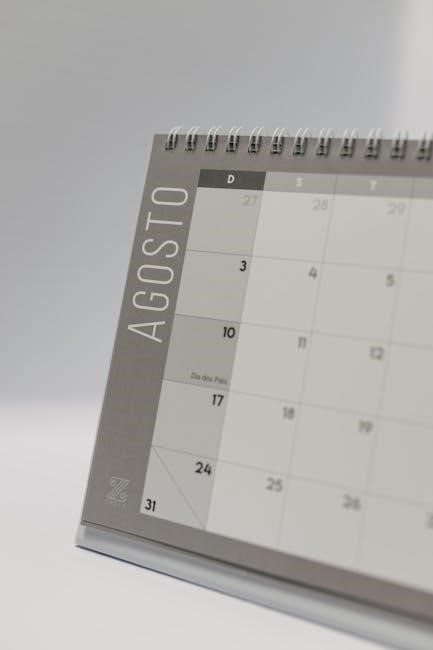The Year 3 and 4 Spelling List is a foundational resource for students in England, outlining 100 essential words to master by age 9․ Available as a PDF, it supports literacy development and confident spelling abilities, serving as a guide for educators and parents alike․
Overview of the Statutory Spelling Requirements

The statutory spelling requirements for Year 3 and 4 students in England are outlined in the National Curriculum, emphasizing 100 specific words that pupils are expected to spell accurately by the end of Year 4․ These words are carefully selected to reflect common vocabulary, spelling patterns, and high-frequency terms essential for fluent writing․ The list includes words such as accidentally, actual, and address, which are grouped into categories like everyday language and more complex patterns․ The requirements ensure consistency in spelling education across schools, providing a clear benchmark for assessment․ Regular practice and reinforcement are encouraged to help students master these words, which are fundamental for their literacy development and confidence in writing․ The list is widely available in PDF formats, offering a convenient resource for teachers, parents, and students to track progress effectively․
Importance of Mastering the Spelling List
Mastering the Year 3 and 4 Spelling List is crucial for developing strong literacy skills and confidence in writing․ Accurate spelling enhances communication, enabling students to express their ideas clearly and effectively․ It also reduces errors in written work, allowing readers to focus on the content rather than mistakes․ By learning these high-frequency words, students build a solid foundation for future academic success․ Spelling proficiency improves overall writing quality, supports grammar and reading comprehension, and fosters creativity in expressing thoughts․ Additionally, it prepares students for more complex vocabulary in higher grades․ The ability to spell correctly boosts self-esteem and encourages a lifelong love for writing․ Regular practice and reinforcement of these words ensure that students meet curriculum expectations and develop skills that are essential for all areas of learning․

Structure of the Year 3 and 4 Spelling List
The list contains , organized by spelling patterns, suffixes, and prefixes․ It includes common exception words and high-frequency vocabulary, structured to progress from simpler to more complex spellings․

Breakdown of the
The Year 3 and 4 Spelling List comprises , divided into categories to aid learning․ These include 20 common exception words that don’t follow standard spelling rules, such as “because” and “they․” The remaining focus on high-frequency vocabulary and words with specific spelling patterns․ Words like “address” and “actual” emphasize the use of suffixes and prefixes․ Others, such as “busy” and “business,” highlight homophones and word families․ The list also includes words that test understanding of word origins, like “calendar” and “centre․” By organizing the words this way, the curriculum ensures a balanced approach to spelling development, helping students build both decoding and encoding skills․ This structured breakdown makes it easier for teachers and parents to create targeted lessons and track progress effectively․
Key Categories and Patterns

The Year 3 and 4 Spelling List is organized into key categories and patterns to help students recognize and remember words more effectively․ One major category includes common exception words, such as “because,” “they,” and “people,” which don’t follow standard spelling rules․ Another category focuses on words with suffixes, like “-able” or “-ment,” such as “enjoyable” and “amusement․” Additionally, the list highlights words with prefixes, such as “unhappy” and “misunderstand․” Homophones like “their/there/they’re” and “your/you’re” are also emphasized to improve accuracy․ Many words feature patterned spelling, such as “busy/business” and “address/addresses,” which share similar roots․ By grouping words into these categories, the curriculum helps students identify relationships and patterns, making spelling more manageable and meaningful․ This approach also supports the development of decoding and encoding skills, essential for confident spelling․

Teaching Strategies for the Spelling List
Effective strategies include multisensory approaches, interactive games, and mnemonics to engage students․ Teachers can use visual aids, phonics, and repetitive practice to reinforce spelling patterns and exceptions, ensuring mastery of the curriculum․
Interactive Activities for Engagement
Engaging students with interactive activities is key to mastering the Year 3 and 4 Spelling List․ Games like spelling bingo and word scrambles make learning fun and competitive․ Using flashcards or apps like Twinkl can reinforce spelling patterns․
Scavenger hunts where students find and spell words around the classroom or home are also effective․ Incorporating movement with spelling obstacle courses or dance and spell activities can enhance retention․
Group work, such as spelling bees or word building challenges, fosters collaboration and healthy competition․ Digital tools like Spelling City or Kahoot! offer interactive quizzes and games to practice spelling in a dynamic way․
These activities not only make learning enjoyable but also help students develop a stronger connection to the words, improving their overall spelling skills․ By incorporating a variety of methods, educators and parents can cater to different learning styles, ensuring every child stays engaged and motivated․
Using Mnemonics and Visual Aids
Mnemonics and visual aids are powerful tools to help students master the Year 3 and 4 Spelling List․ Techniques like creating acronyms or rhymes can make complex words easier to remember․ For example, using the phrase “A Cat in Gloves Catches No Mice” to remember the word “accidentally․”
Visual aids such as mind maps, word diagrams, and flashcards can also enhance learning․ Tools like Twinkl offer printable resources, including word cards and spelling posters, to support visual learners․
Students can draw pictures that represent the shape or meaning of a word, aiding retention․ Mnemonics and visuals cater to different learning styles, making spelling practice more effective and engaging․ These methods help students connect words to memorable images or phrases, reducing the likelihood of mistakes and building confidence in their spelling abilities․ Regular use of these strategies can significantly improve mastery of the Year 3 and 4 Spelling List․
Incorporating Technology in Learning
Technology offers innovative ways to engage students with the Year 3 and 4 Spelling List․ Educational apps like Twinkl and Spelling Shed provide interactive games and activities that make spelling practice fun․ These tools often include audio pronunciations, quizzes, and progress tracking to personalize learning․
Digital flashcards and spelling games can be accessed on tablets or smartphones, allowing students to practice anywhere․ Some apps incorporate gamification, where students earn rewards for mastering words, boosting motivation․
Interactive whiteboards in classrooms enable teachers to create dynamic lessons, while online resources like spelling videos and animated tutorials cater to visual learners․ Technology also offers multisensory approaches, combining sight, sound, and touch to reinforce spelling skills․ By leveraging these tools, students can develop a stronger connection to the words and enjoy the learning process․ This modern approach ensures that spelling practice is both effective and enjoyable, preparing students for long-term success․

Resources for Practicing the Spelling List
Utilize workbooks, online tools, and printable worksheets to enhance spelling practice․ Websites like Twinkl offer comprehensive resources, including games and activities, to support mastery of the Year 3 and 4 Spelling List․
Recommended Workbooks and Guides
Several workbooks and guides are available to support practice of the Year 3 and 4 Spelling List․ Popular options include Twinkl resources, which offer structured spelling activities and exercises․ These workbooks are designed to align with the National Curriculum, ensuring comprehensive coverage of all ․ Many guides feature interactive elements, such as word searches, crossword puzzles, and writing challenges, to engage learners․ They also provide revision sections and assessment grids to track progress․ Some workbooks cater to different learning styles, incorporating visual aids and mnemonic devices to enhance retention․ Additionally, PDF versions of these resources are widely available, making them accessible for home and classroom use․ These tools are invaluable for reinforcing spelling skills and building confidence in young learners․ By using these workbooks, students can systematically master the spelling list and improve their overall literacy abilities․
Online Tools and Apps
There are numerous online tools and apps designed to help students practice and master the Year 3 and 4 Spelling List․ Websites like Twinkl offer interactive spelling games, quizzes, and activities tailored to the National Curriculum․ These resources often include features like audio pronunciation, word building exercises, and progress tracking to monitor improvement․ Apps such as Spelling Shed and Teach Your Monster to Read provide engaging, gamified learning experiences for children․ Many platforms allow customization, enabling teachers and parents to focus on specific words or categories․ Additionally, some apps incorporate multiplayer modes, fostering friendly competition and collaboration․ These digital tools make spelling practice accessible, fun, and effective, helping students develop confidence and fluency in their spelling abilities․ They are particularly useful for modern learners who enjoy interactive and dynamic learning environments․
Printable Worksheets and Games
Printable worksheets and games are excellent resources for practicing the Year 3 and 4 Spelling List․ Websites like Twinkl offer a variety of downloadable PDFs, including word searches, crossword puzzles, and bingo games․ These activities make spelling practice engaging and fun, helping students develop their skills in an interactive way․ Many worksheets feature themed designs, such as seasonal or animal-themed pages, to keep children interested․ Games like spelling bingo or matching activities encourage active participation and teamwork․ Additionally, printable spelling grids and word cards provide structured practice for individual or group use․ These resources are ideal for reinforcing classroom learning or for home practice․ Parents and educators can easily print and customize them to suit different learning needs, ensuring children stay motivated and confident as they work through the spelling list․

Assessment and Progress Tracking
Regular spelling tests and checklists help track progress․ Assessments identify strengths and areas needing improvement, ensuring targeted support․ Frequent evaluations provide insights into learning development, aiding effective teaching strategies․
Creating a Spelling Checklist
A spelling checklist is an essential tool for tracking progress․ It allows teachers and parents to monitor which words students have mastered and which require further practice․ By organizing the 100 statutory words into categories or groups, the checklist provides a clear overview of achievements․ Each word can be marked as “R” for recognized, “W” for written correctly, or “RW” for fully mastered․ Regularly updating the checklist helps identify patterns of difficulty and ensures targeted support․ Additionally, checklists can be personalized to focus on specific areas, such as common exceptions or high-frequency words․ This structured approach not only enhances accountability but also motivates students to see their progress over time․ Utilizing checklists alongside other assessment methods creates a comprehensive framework for effective spelling development․
Setting Achievable Milestones
Setting achievable milestones is crucial for helping students progress through the Year 3 and 4 Spelling List․ By breaking the into smaller, manageable groups, educators and parents can create clear, short-term goals․ For example, focusing on per week allows students to practice and master them before moving on․ Milestones should be realistic and aligned with individual learning paces, ensuring no child feels overwhelmed․ Celebrating the completion of each milestone builds confidence and motivation․ Regular reviews and adjustments to these targets help maintain a steady pace and address any gaps in learning․ Incorporating positive reinforcement, such as stickers or praise, further encourages students to stay engaged․ By structuring learning in this way, milestones become stepping stones toward mastering the entire spelling list by the end of Year 4․
Using Quizzes and Tests Effectively
Quizzes and tests are valuable tools for assessing students’ mastery of the Year 3 and 4 Spelling List․ Regular spelling tests help identify gaps in knowledge and track progress over time․ Teachers can use these assessments to pinpoint challenging words and provide targeted support․ Quizzes can be informal, such as online games or flashcard activities, making learning engaging․ Formal tests, on the other hand, allow for a comprehensive review of the spelling list․ By incorporating a mix of both, educators ensure students are well-prepared․ Celebrating correct spellings and offering constructive feedback on errors fosters a positive learning environment․ Additionally, timed tests can help students build confidence for future assessments․ Overall, quizzes and tests serve as effective ways to evaluate progress, reinforce learning, and motivate students to achieve their spelling goals throughout the year․

Common Challenges in Spelling
Mastering the Year 3 and 4 Spelling List can be challenging due to irregular patterns, tricky homophones, and less frequent word usage․ Building confidence and consistent practice are key to overcoming these hurdles․
Identifying Difficult Words
Identifying difficult words in the Year 3 and 4 Spelling List requires careful analysis of each student’s strengths and weaknesses․ Words like “accidentally” and “actual(ly)” often pose challenges due to their complex letter combinations and silent letters․ Homophones, such as “their” and “there,” can also be confusing․ Additionally, words with irregular spelling patterns, like “calendar” and “business,” frequently trip students up․ Teachers and parents can use the statutory checklist to pinpoint these tricky words and create targeted practice sessions․ Regular assessment and feedback help in early identification of struggling areas, allowing for intervention before these difficulties become ingrained․ By focusing on these challenging words, educators can provide tailored support, ensuring students build confidence and mastery over time․ This individualized approach is crucial for helping students overcome spelling obstacles and achieve long-term success in literacy․
Addressing Spelling Mistakes
Addressing spelling mistakes effectively is crucial for building confidence and improving accuracy․ When a student misspells a word, it’s important to correct it immediately and provide clear feedback․ For example, words like “accidentally” and “actual(ly)” often confuse students due to their complex letter patterns․ Teachers and parents should encourage students to revisit these words, breaking them down into smaller parts for easier retention․ Highlighting common errors, such as mixing up “their” and “there,” can also help students understand the context in which words are used․ Creating a “mistake log” allows students to track and review their most frequent errors, fostering a growth mindset․ Additionally, incorporating games and activities that focus on problem areas can make learning engaging․ By addressing mistakes constructively and providing targeted practice, students can overcome challenges and develop a stronger foundation in spelling․ This approach ensures that errors are viewed as opportunities for growth rather than failures․
Building Confidence in Spellers
Building confidence in young spellers is essential for their academic success and lifelong learning․ One effective strategy is to create a positive and supportive environment where mistakes are seen as learning opportunities․ Praising effort and progress, no matter how small, encourages students to take risks and persevere․ Providing achievable goals, such as mastering a few words at a time, helps build a sense of accomplishment․ Incorporating games, quizzes, and interactive activities makes spelling fun and engaging, reducing anxiety․ Additionally, allowing students to use technology, like spelling apps or online tools, can make practice feel less daunting and more enjoyable․ Celebrating successes, whether through reward systems or sharing achievements with peers, fosters pride and motivation․ By focusing on confidence-building techniques, educators and parents can help students develop a positive attitude toward spelling and a belief in their abilities to master the Year 3 and 4 Spelling List․

Additional Tips for Parents and Educators
Parents and educators can enhance learning by integrating spelling into daily routines, using visual aids, and providing individualized support․ Encouraging practice through fun activities fosters engagement and progress effectively․
Encouraging Daily Practice
Consistency is key to mastering the Year 3 and 4 Spelling List․ Parents and educators should create a routine where children practice spelling daily, even for short periods․ Using the Year 3 and 4 Spelling List PDF, activities like writing words in sand, tracing with fingers, or using magnetic letters can make practice engaging․ Incorporating games such as spelling bees, bingo, or matching games adds fun and competition, motivating children to learn․ Additionally, integrating spelling into everyday tasks, like writing grocery lists or notes, helps reinforce the words in a practical context․ Regular review of previously learned words ensures retention and builds confidence over time․ By making spelling a positive and consistent part of daily life, children develop strong literacy skills that benefit them in all areas of education․
Making Spelling Fun and Relevant
Making spelling engaging for Year 3 and 4 students is crucial for their learning success․ The Year 3 and 4 Spelling List PDF provides a structured approach to practice, but incorporating creative methods enhances interest and retention․ Interactive games such as Scrabble, Boggle, or online apps can transform spelling practice into an enjoyable activity․ Using real-life contexts, like writing stories or creating posters with target words, helps students see the relevance of spelling․ Activities like spelling relays or team challenges foster collaboration and healthy competition․ Additionally, utilizing visual aids like word cards or spelling grids can make learning more interactive․ By connecting spelling to their interests and daily lives, educators and parents can make the process both fun and meaningful, ensuring that students remain motivated and invested in their learning journey․
Providing Individualized Support
Every child learns at their own pace, making individualized support essential for mastering the Year 3 and 4 Spelling List․ The statutory spelling list PDF offers a clear framework to identify areas where students may need extra help․ Teachers and parents can create personalized learning plans tailored to each child’s strengths and challenges․ For instance, students struggling with specific patterns like silent letters or homophones can benefit from targeted practice sheets․ Regular one-on-one sessions allow for focused feedback and encouragement․ Additionally, incorporating the spelling list into daily routines, such as morning work or homework, ensures consistent practice․ By adapting teaching methods to meet individual needs, educators can help students build confidence and fluency in spelling․ This approach not only addresses gaps but also fosters a love for learning, making the journey through the spelling list more enjoyable and effective․


